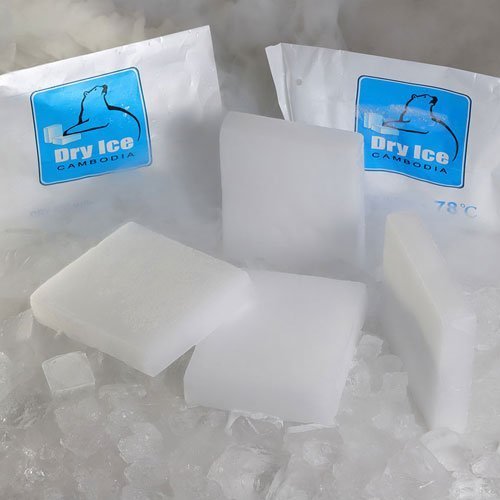Dry ice has long fascinated those who work with it, from event planners and scientists to the general public intrigued by its dramatic fog effects. Unlike regular ice, which is made from water, dry ice is solid carbon dioxide (CO₂) and sublimates directly from a solid to a gas at -78.5°C (-109.3°F). This unique property makes it an invaluable tool in a variety of applications, from preserving frozen goods to creating eerie fog for Halloween.
However, one common question that arises is, “How long does dry ice last?” In this comprehensive guide, we’ll explore the factors that affect the lifespan of dry ice, its uses, and how to maximize its effectiveness.

Understanding Dry Ice
What is Dry Ice?
Dry ice is the solid form of carbon dioxide, a gas that makes up about 0.04% of the Earth’s atmosphere. Unlike regular ice, dry ice doesn’t melt into a liquid when it warms up. Instead, it sublimates directly into carbon dioxide gas. This process creates the fog-like effect that dry ice is famous for.
How Does Dry Ice Work?
When dry ice sublimates, it releases a cold gas that can create a dense fog effect, particularly when it comes into contact with water. This fog is often used for special effects in theater, film, and parties. In addition to its visual appeal, dry ice is also used for cooling and preserving items because of its extremely low temperature.
Factors Affecting Dry Ice Longevity
Storage Conditions:
The lifespan of dry ice is significantly influenced by how it is stored. Dry ice sublimates faster in warmer conditions, so it should be stored in a well-insulated container to slow down this process. An insulated cooler or special dry ice container is ideal. Avoid using airtight containers, as the pressure build-up from the sublimated gas can cause the container to burst.
Size and Quantity:
The size and amount of dry ice also affect how long it lasts. Larger blocks of dry ice have a slower sublimation rate compared to smaller pellets or chips. This is because a larger volume has a lower surface area-to-volume ratio, reducing the rate at which it sublimates.
Airflow:
Exposure to air accelerates the sublimation process. Keeping dry ice in a tightly sealed container helps minimize exposure to air, thereby extending its lifespan. Conversely, frequent handling or placing it in a location with high air circulation can cause it to sublimate more quickly.
Ambient Temperature:
The temperature of the environment where dry ice is stored also plays a crucial role. Dry ice sublimates faster in warmer temperatures, so storing it in a cool place will help prolong its duration. If possible, keep it in a shaded area away from direct sunlight or heat sources.
Type of Container:
The type of container used to store dry ice can impact its longevity. Insulated coolers are preferred over regular plastic or cardboard boxes. High-quality insulated containers are designed to minimize heat transfer, slowing down the sublimation rate. Specialized dry ice containers often have additional features to manage pressure build-up.
Typical Longevity of Dry Ice
Small Pellets or Chips:
Dry ice in pellet or chip form typically lasts between 12 to 24 hours, depending on storage conditions. These smaller pieces have a higher surface area relative to their volume, causing them to sublimate more quickly. They are often used for short-term cooling or immediate effects.
Large Blocks:
Large blocks of dry ice can last from 24 to 48 hours or even longer under optimal conditions. Their slower sublimation rate makes them more suitable for extended cooling needs or for applications requiring a longer-lasting effect. Proper storage in an insulated container can further extend their lifespan.
Sublimation Rate:
On average, dry ice sublimates at a rate of about 5 to 10 pounds every 24 hours, depending on the size of the pieces and storage conditions. This rate can vary based on factors such as the container’s insulation, ambient temperature, and the amount of dry ice.
Practical Uses and Applications
Cooling and Preservation:
Dry ice is commonly used for preserving perishable items during transport. It’s often employed in shipping pharmaceuticals, biological samples, and frozen foods. For these applications, the longevity of dry ice is crucial to ensuring that products remain at the required temperature.
Special Effects:
In entertainment, dry ice is used to create fog effects for theatrical productions, concerts, and parties. The duration of these effects depends on the amount of dry ice used and how it’s handled. For a continuous effect, a larger quantity of dry ice may be necessary.
Cleaning:
Dry ice blasting is a method used for cleaning industrial equipment. This technique uses dry ice pellets to remove contaminants without causing damage to the equipment. The longevity of dry ice for this purpose depends on the size of the pellets and the amount used during the cleaning process.
Science Experiments:
Dry ice is often used in educational demonstrations and experiments to illustrate sublimation and the properties of gases. The duration of the dry ice used in these experiments is typically short, but understanding its sublimation rate helps in planning experiments effectively.
Tips for Maximizing Dry Ice Longevity
Use Insulated Containers:
Invest in high-quality insulated coolers or specialized dry ice containers to slow down sublimation. These containers are designed to minimize heat transfer and can significantly extend the life of your dry ice.
Minimize Air Exposure:
Keep dry ice in a sealed container to reduce its exposure to air. Frequent opening of the container will allow warm air in, accelerating the sublimation process.
Store in a Cool Place:
Keep your dry ice in a cool environment away from direct sunlight and heat sources. A shaded, cool area helps slow down the sublimation rate.
Plan Usage:
Calculate the amount of dry ice you need based on your specific application. Using the right quantity can help manage how long it lasts and ensure it meets your needs.
Handle with Care:
Avoid handling dry ice with bare hands. Use gloves or tongs to prevent frostbite and reduce the amount of heat transferred from your hands to the dry ice, which can speed up sublimation.
Conclusion
Understanding how long dry ice lasts involves considering several factors, including storage conditions, size, airflow, and ambient temperature. On average, dry ice in small pellet or chip form lasts between 12 to 24 hours, while large blocks can last from 24 to 48 hours or longer. By using insulated containers, minimizing air exposure, and storing dry ice in a cool environment, you can maximize its longevity and effectiveness for various applications.
Whether you’re using dry ice for cooling, special effects, cleaning, or educational purposes, knowing how to manage and extend its lifespan can help you achieve the best results and make the most out of this fascinating substance.



